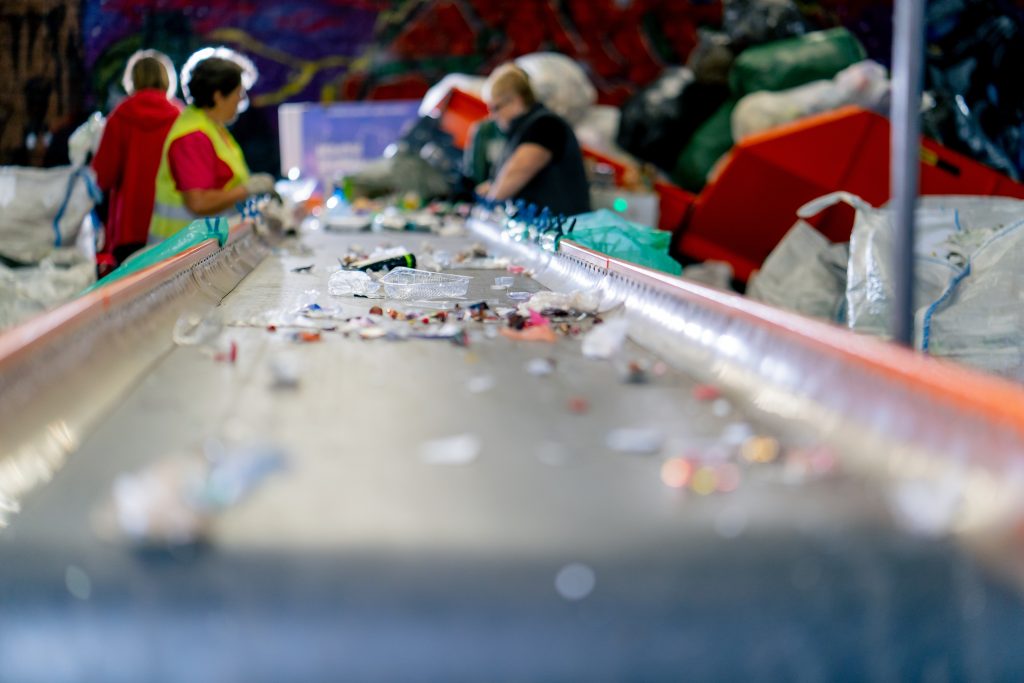How Does Recycling Work?

Recycling is an essential process that helps reduce waste, conserve natural resources, and protect the environment. However, many people are still unclear about how recycling works, or what happens to their discarded items once they leave their homes.
To understand this process better, let’s break down the key steps involved in recycling dry mixed waste including paper/plastics/metal/glass, from the moment you place that empty bottle into the bin to its reincarnation into a new product.
- Collection and Transportation
The first step in the recycling process occurs when recyclables are collected from curbside bins or local recycling centres. Different materials like paper, plastics, glass and metals are typically separated into designated bins to streamline the recycling process. Once the collection is done, the materials are transported to a materials recovery facility (MRF), where they will undergo sorting and processing.
- Sorting and Separation
At the MRF, recycling items are sorted based on their type. This stage is crucial to ensure that materials that can be recycled don’t get contaminated with non-recyclables, which can complicate the recycling process. Sorting is done through both manual labour and automated machinery, including:
- Shakers and Air classifiers: These help separate lightweight materials, like paper, from heavier materials like glass or metals.
- Magnets: These are used to remove steel and iron-based items.
- Optical Sorters: These identify materials based on their specific properties, like plastics or different types of glass, and sort them accordingly.
Once sorted, materials are cleaned to remove contaminants like food waste, oils, or chemicals, which could affect the quality of the recycled products.
- Processing and Shredding
After the materials have been sorted and cleaned, they are sent to specialised facilities where they are processed into reusable raw materials. Different types of materials undergo different processes:
- Plastics: These are shredded into small pieces, cleaned further and sometimes melted down. Once processed, they can be made into new plastic products, such as containers, bags, or even clothing.
- Paper: The paper is pulped, turning it into slurry. This mixture is then dried into sheets of recycled paper, which can be used to make newspapers, cardboard, or new paper products.
- Glass: Glass is crushed into small pieces called cullet. This glass can then be melted down and reused to create new bottles, jars, or even fiberglass.
- Metals: Metals like aluminium and steel are smelted in high-temperature furnaces to remove impurities, after which they can be used to create new metal products, from cans to construction materials.

- Manufacturing New Products
Once the materials are processed and transformed into raw material forms, they are sent to manufacturers who use them to make new products. The beauty of recycling lies in its ability to give old products a second life. For example:
- Recycled aluminum is used to create new cans, cars and airplanes.
- Recycled paper may become newspapers, magazines, or even packaging materials.
- Recycled plastic is often used to create bottles, containers, or outdoor furniture.
The more recycling that happens, the fewer virgin materials need to be extracted from the Earth, helping to preserve valuable resources like timber, metals and oil.
- Selling and Distribution
Once new products are made, they are put up for sale and distributed. Consumers can purchase these products, and the cycle begins again. For example, a recycled aluminium can might return to a supermarket shelf, where it will eventually be used, discarded and sent back to the recycling process.
- Closing the Loop
The final step in recycling is the concept of closing the loop. In an ideal recycling system, the materials that have been recycled into new products (like single-use bottles turning into the Honest Bottle) will eventually go back into the recycling system once they reach the end of their life cycle. The more we recycle, the less waste ends up in landfills and incinerators, contributing to a more sustainable future.
Benefits of Recycling
- Conservation of Resources: Recycling helps conserve natural resources like trees, minerals and fossil fuels by reusing materials that would otherwise be wasted.
- Energy Savings: Recycling often uses less energy than producing new items from raw materials. For example, recycling aluminium uses 95% less energy than making it from bauxite ore.
- Reduction of Landfill and Incineration Waste: Recycling reduces the volume of waste sent to landfills or incinerators, extending their lifespan and reducing environmental harm.
- Economic Benefits: Recycling creates jobs in the sorting, processing and manufacturing sectors, contributing to a green economy.

Challenges in Recycling
While recycling is beneficial, it’s not without its challenges:
- Contamination: Non-recyclable materials mixed with recyclables can contaminate entire batches, making them unusable.
- Consumer Awareness: In some areas, people may not fully understand what can and cannot be recycled, leading to inefficiencies.
- Cost: The recycling process can be expensive, especially when contamination is high or when markets for certain materials fluctuate.
Recycling is a vital process that contributes to a more sustainable world. By understanding how it works, you can make more informed decisions about what to recycle and how to properly dispose of your waste. Whether it’s through curb side programs, community recycling centres or specialized drop-off points, each step you take to recycle contributes to a cleaner environment and a healthier planet for future generations.
The simple act of recycling may seem small, but it is a powerful step toward creating a circular economy where resources are used, reused and never wasted.